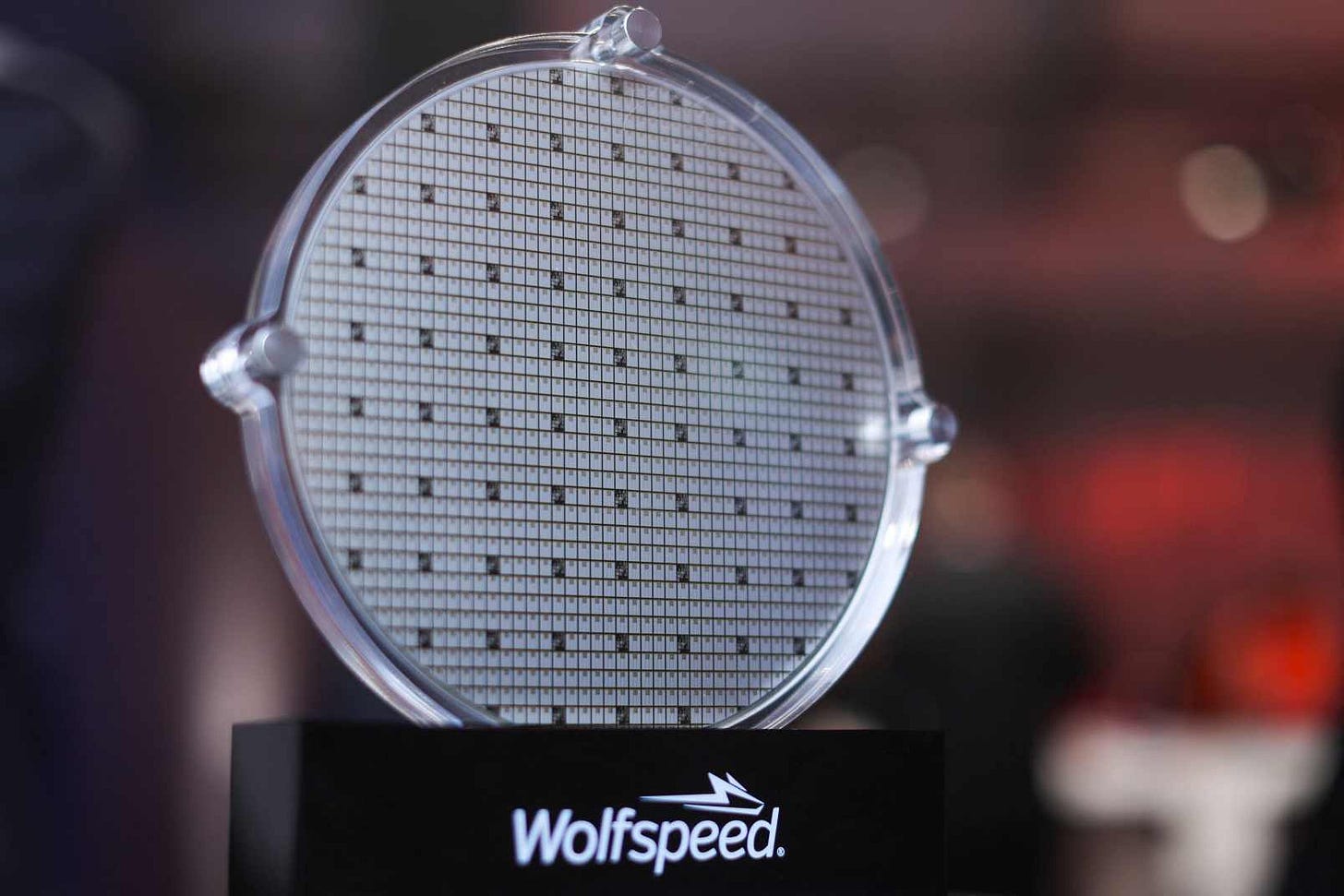Exclusive: Episil’s J. H. Shyu on Wolfspeed’s Collapse, Navitas’s Surge, and NVIDIA’s SiC Power Play
Liang-rong Chen
Hello everyone,
Last weekend, I visited a local theater and watched the semiconductor documentary A Chip Odyssey(《造山者—世紀的賭注》). It was deeply moving to see the late Professor Chyuan-Yuan Wu(吳泉源) of National Tsing Hua University and Professor Simon M. Sze(施敏) speaking so vividly in the film.
One of the moments that resonated most with audiences was when Taiwan’s semiconductor pioneers, now industry legends, recalled their youthful days training at RCA. They were brought to tears remembering how, back then, they couldn’t even afford McDonald’s and instead focused on documenting every detail of semiconductor manufacturing to bring back to Taiwan—driven by the words of then-Minister Sun Yun-suan(孫運璿): “You must succeed. Failure is not an option.”
In fact, the early histories of Japan’s and Korea’s semiconductor industries are also filled with similar tales—young engineers on determined missions to learn from the U.S.
Sony was the earliest. When Bell Labs had just invented the transistor, Sony co-founder Masaru Ibuka had the foresight to secure licensing. In 1954, Kazuo Iwama (Akio Morita’s brother-in-law) was sent to the U.S. to learn the technology—more than 20 years before Taiwan’s mission.
Iwama spent three months observing factories and labs by day, then meticulously documenting every process in pages full of diagrams and technical English at night. Three years later, Sony launched the world’s first pocket-sized transistor radio using its own transistors.
Today, Iwama’s 44-page “Iwama Report” has become an important historical document for Sony. “The raw energy on those densely written pages was the driving force behind Japan’s post-war recovery,” wrote SONY: The Private Life.
Korea came a few years after Taiwan. In the 1980s, Samsung’s Lee Kun-hee sought to enter the DRAM market. At the time, only a struggling Micron was willing to license the technology—under one harsh condition: Samsung engineers could not touch Micron’s computers.
“So Samsung’s engineers widened their eyes, carefully memorizing every chart they saw... Every night back at the hotel, they would painstakingly recreate those diagrams from memory—reconstructing the incredibly complex semiconductor schematics piece by piece,” recounted Samsung Rising.
But Taiwan’s story had a crucial difference: the 44-member RCA mission was a national endeavor, aiming to establish an entirely new industry upon their return, rather than for a single company or product.
This ambitious vision is perhaps the main reason why Taiwan’s semiconductor industry has been able to flourish and dominate Asia.
Now, back to this edition of the newsletter.
This is actually my third extended report from COMPUTEX Taipei. The first covered my interview with Cooler Master on liquid cooling. The second explored how TSMC’s next-generation CoWoS is driving a power revolution in AI data centers.
And this piece continues that theme—an exclusive interview with Episil(漢磊) Chairman J.H. Shyu(徐建華), on a news item from Nvidia that went mostly unnoticed during COMPUTEX: its new power architecture, which may help breathe new life into a silicon carbide industry caught in a price war.
Enjoy the latest edition!
The once-booming third-generation semiconductor industry (known as ‘third-generation’ in China) has recently undergone dramatic changes.
Wolfspeed, the long-dominant U.S. leader in SiC technology, saw its stock price collapse after a Wall Street Journal report in late May revealed the company was preparing to file for bankruptcy protection.
Conversely, Navitas, which only listed on Nasdaq in 2021, has seen its stock price surge by 2.5 times in the past month.
Why have these two U.S.-based SiC players faced such divergent outcomes?
“The keyword is application market,” explained J. H. Shyu(徐建華), Chairman of Episil Technologies Inc. (漢磊), Taiwan’s largest SiC foundry. “Wolfspeed’s success and failure are both tied to electric vehicles.”
Silicon carbide, with its ability to withstand high voltage and high temperatures, has long been the “dream material” for power components. However, due to its extreme manufacturing difficulty, it remained in niche markets. That changed in 2019, when Tesla deployed SiC in the Model 3’s inverter to reduce vehicle weight and improve energy efficiency, an innovation that sent shockwaves through the industry.
“Everyone was stunned that this dream material was actually usable,” said Yi-Jen Chan(詹益仁), CTO of Cyntec(乾坤科技), in an episode of my podcast “Tech Taiwan.”
It marked the peak of Wolfspeed’s success, as the company controlled the critical technology for manufacturing silicon carbide wafers (also known as substrates). Major power component manufacturers like Infineon(英飛凌), Renesas, and automakers like Volkswagen eagerly sought partnerships. The SiC industry then boomed, until Chinese companies flooded the market and the EV sector recently entered a downturn, leading to massive SiC wafer oversupply.
Nvidia Unlocks a New SiC Market
Just as the EV-driven SiC market cooled, a new tech giant stepped in to open up an entirely new market: Nvidia.
On May 20, on the opening day of COMPUTEX Taipei, Nvidia announced that it would introduce a new 800-volt high-voltage DC power supply architecture to its AI data centers by 2027.
Surprisingly, Navitas was listed among Nvidia’s six announced chip partners, alongside established giants like Infineon, STMicroelectronics, and Texas Instruments. The very next day, Navitas’s stock price soared by 188% in a single day.
“This is a major turning point,” J. H. Shyu said enthusiastically. He had long believed that AI servers would increasingly adopt SiC components, and some of his clients’ products had already entered this field.
Now Nvidia is moving decisively: stepping voltage down from 13,000-volt industrial input all the way to 800-volt DC at the rack level. “This will absolutely be silicon carbide’s territory,” Shyu noted.
Nvidia’s technical white paper states that in the future, a single server rack will consume up to 1MW, and a data center will reach 1GW of power consumption.
Nvidia explained that if the existing 54-volt DC power distribution were to be maintained, a single rack would require 200 kilograms of copper cables for conduction.
Therefore, switching to the new 800V architecture dramatically reduces current flow, cutting copper usage by 45%, while also simplifying the power supply structure and improving power efficiency by more than 5%. Navitas even claims its design could push efficiency to an astonishing 98%.
What does this mean? According to Delta Electronics(台達電), current AI data centers achieve just 87.6% power efficiency, meaning 12.4% of power turns into heat. If losses fall to just 2%, cooling demand could drop by 84%, a huge energy savings.
Navitas is no stranger to Taiwan’s tech industry. In the previous wave of third-generation semiconductor innovation—when the iPhone adopted Gallium Nitride (GaN) fast charging in 2020—Navitas was the exclusive power component supplier, gaining significant recognition. Navitas also acquired the SiC startup GeneSiC in 2022, giving it a complete portfolio across third-generation semiconductors. The industry speculates that this is a major reason why Navitas gained Nvidia’s favor.
Episil Bets Big on SiC Foundry
Notably, Navitas’s GaN chips are fabricated by TSMC, while its SiC components are outsourced to Germany’s X-Fab. Currently, there are only two professional SiC foundries worldwide, the other being Episil.
Will the hottest SiC company become an Episil client?
“We’ll definitely try to win them over,” J. H. Shyu did not deny, “We have an edge.”
Episil is collaborating with VIS (世界先進) to convert an old 8-inch fab into SiC production by late 2026, offering better scale and pricing than X-Fab’s existing 6-inch lines.
This represents Taiwan’s semiconductor industry's boldest move to counter China’s massive push into mature process nodes.
To this end, VIS invested NT$2.48 billion last year for a 13% stake and two board seats in Episil. Given that VIS is a TSMC subsidiary, Episil is now widely seen as part of the greater TSMC family.
Episil’s willingness to expand against the market cycle draws on Taiwan’s foundry industry playbook. IDMs tend to hold back on capacity during downturns, positioning Episil to capture share when the market recovers.
Why Are Major Players Exiting the Market?
Signs of this trend are already visible. Japanese IDM giant Renesas, which only entered the SiC market in 2023 with a 10-year, $2 billion supply deal with Wolfspeed, abruptly dissolved its Takasaki SiC team just a year later.
Renesas CEO Hidetoshi Shibata called the market outlook “extremely pessimistic” in February. Chinese Nikkei reported that government subsidies to Chinese competitors made the market unprofitable.
Wolfspeed could well be the next major IDM to exit the market. The world’s only silicon carbide company fully integrated from wafers to devices, it traces its roots to Cree—once a top-five global LED player, before intense competition from China drove it out of that market.
Once again, its downfall was triggered by overreach—trying to push its wafer monopoly further downstream, Wolfspeed poured resources into building a new 8-inch fab to produce power devices in-house.
This left the company with $6.5 billion in debt. When market conditions soured, its business collapsed.
It raises the question: Why did it repeat the same mistake, after having already been burned by China’s red supply chain once before?
How China’s Red Supply Chain Took Down Wolfspeed
J. H. Shyu believes Wolfspeed underestimated China’s capacity to catch up, assuming SiC would remain too complex. “It probably thought it was fine,” he said. “At that time, everyone thought that stuff was incredibly hard to make.”
Indeed, SiC, second only to diamond in hardness, is difficult to process. While silicon ingots can grow two meters long and yield thousands of wafers, SiC requires sublimation growth at 2000°C—taking a week to produce just 3–4 cm, yielding only 20–30 wafers.
However, the LED tragedy repeated itself. In just a few years, the price of 6-inch SiC wafers plummeted from a peak of $1,500 to less than $300 today, an 80% drop, below the production costs for both Wolfspeed and Chinese companies.
J. H. Shyu rattled off more than a dozen Chinese SiC companies, such as SICC(山東天岳) and TanKeBlue Semiconductor(天科合達), whose quality now rivals that of European and American peers, with full international competitiveness.
How did they pull this off? “It’s brute-force scaling,” J. H. Shyu explained. In most cases, companies buy SiC growth furnaces by the dozens. But with third-gen semiconductors designated as a strategic industry, Chinese players spared no expense, placing orders for hundreds of furnaces at once. That let them rapidly test, learn, optimize production, and scale fast.
This mirrors a larger trend in China’s economy, where the government is aggressively channeling resources into strategic industries to boost exports and stimulate growth. The outcome: severe overcapacity in the so-called “new three” sectors—electric vehicles, solar energy, and lithium batteries.
Nowhere is China’s dominance more absolute than in solar. Rivals from Taiwan, Japan, and the U.S. have largely exited after years of losses, with Chinese firms now controlling the entire supply chain, from materials and equipment to technology and systems.
A foreign analyst remarked that if current trends continue, the SiC market could soon mirror what happened in solar—becoming an all-China game. Case in point: Chinese vendors are now making crystal growth furnaces themselves.
How AI Data Centers Are Saving the Silicon Carbide Industry
But the AI data center market could change everything.
AI is the most geopolitically sensitive U.S.-China tech battleground, with American firms dominating both technology and market access, and likely to block Chinese suppliers.
J. H. Shyu stated that Nvidia’s 800-volt white paper was only released a month ago, and everyone is still in the research phase.
But he agrees, “Given geopolitics, U.S. companies will likely prioritize non-China solutions, even without formal mandates.”
Looking ahead, he expects China and the U.S. to develop parallel, self-contained AI data center ecosystems. “Our goal is to stay competitive in both markets,” he added.
Read more here
The Biggest Winner in the Liquid Cooling Boom: NVIDIA’s Most Mysterious Unlisted Supplier in Taiwan
TSMC’s Next-Gen CoWoS Hits Like a Death Note for Delta and Infineon
[Exclusive] “China’s Nvidia”: Cambricon and SiCarrier’s Disruption of the Chip Supply Chain





